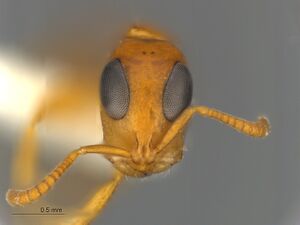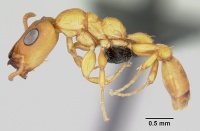Tetraponera ophthalmica
| Tetraponera ophthalmica | |
|---|---|

| |
| Scientific classification | |
| Kingdom: | Animalia |
| Phylum: | Arthropoda |
| Class: | Insecta |
| Order: | Hymenoptera |
| Family: | Formicidae |
| Subfamily: | Pseudomyrmecinae |
| Genus: | Tetraponera |
| Species group: | ambigua |
| Species: | T. ophthalmica |
| Binomial name | |
| Tetraponera ophthalmica (Emery, 1912) | |
| Synonyms | |
| |
Occurs in west Africa and central Africa in areas of higher rainfall. It is apparently a generalist inhabitant of dead twigs.
Identification
A member of the Tetraponera ambigua-group.
Ward (2018) - This species can be readily distinguished from Tetraponera ambigua by its smaller size, disproportionately larger eyes, and much sparser standing pilosity. The anterior clypeal margin of queens and soldiers is adorned with a single median tooth, especially stout in soldiers (anterior clypeal margin usually crenulate or bluntly tridentate in queens and soldiers of T. ambigua). For differences between T. ophthalmica and Tetraponera parops see under the latter species.
Keys including this Species
- Key to Afrotropical Tetraponera
- Key to Afrotropical Tetraponera species
- Key to Tetraponera ambigua group species
Distribution
Latitudinal Distribution Pattern
Latitudinal Range: 6.15° to -7.4°.
| North Temperate |
North Subtropical |
Tropical | South Subtropical |
South Temperate |
- Source: AntMaps
Distribution based on Regional Taxon Lists
Afrotropical Region: Cameroun (type locality), Central African Republic, Democratic Republic of Congo, Equatorial Guinea, Gabon, Ghana, Guinea, Kenya, Nigeria, Uganda.
Distribution based on AntMaps
Distribution based on AntWeb specimens
Check data from AntWeb
Countries Occupied
| Number of countries occupied by this species based on AntWiki Regional Taxon Lists. In general, fewer countries occupied indicates a narrower range, while more countries indicates a more widespread species. |

|
Estimated Abundance
| Relative abundance based on number of AntMaps records per species (this species within the purple bar). Fewer records (to the left) indicates a less abundant/encountered species while more records (to the right) indicates more abundant/encountered species. |

|
Biology
Castes
Worker
          
| |
| . | |
Queen
Images from AntWeb
   
| |
| Queen (alate/dealate). Specimen code casent0087124. Photographer April Nobile, uploaded by California Academy of Sciences. | Owned by CAS, San Francisco, CA, USA. |
Nomenclature
The following information is derived from Barry Bolton's Online Catalogue of the Ants of the World.
- ophthalmica. Sima ophthalmica Emery, 1912b: 98 (w.) CAMEROUN. Combination in S. (Tetraponera): Emery, 1921f: 28; in Tetraponera: Wheeler, W.M. 1922a: 107. Senior synonym of nasuta, tenebrosa, unidens: Ward, 2006: 126.
- tenebrosa. Tetraponera ophthalmica var. tenebrosa Santschi, 1928d: 61 (w.) DEMOCRATIC REPUBLIC OF CONGO. Junior synonym of ophthalmica: Ward, 2006: 126.
- unidens. Tetraponera ophthalmica st. unidens Santschi, 1928d: 60, fig. 2 (q.) DEMOCRATIC REPUBLIC OF CONGO. Junior synonym of ophthalmica: Ward, 2006: 126.
- nasuta. Tetraponera nasuta Bernard, 1953b: 222, fig. 7 (q.) GUINEA. Terron, 1971: 74 (s.w.m.). Junior synonym of ophthalmica: Ward, 2006: 126.
Unless otherwise noted the text for the remainder of this section is reported from the publication that includes the original description.
Description
Worker
Ward (2018) - (n = 11). HW 0.52 - 0.59, HL 0.71 - 0.88, LHT 0.46 - 0.56, CI 0.67 - 0.73, FCI 0.15 - 0.19, REL 0.45 - 0.50, REL2 0.64 - 0.71, SI 0.60 - 0.65, SI3 0.85 - 0.96, FI 0.42 - 0.47, PLI 0.47 - 0.56, PWI 0.35 - 0.46, LHT / HW 0.89 - 0.99, CSC 2 - 4, MSC 0 - 2.
Relatively small species with elongate head and large eyes; masticatory margin of mandible with four teeth; clypeus narrow and protruding anteromedially; median lobes of antennal sclerites expanded laterally and covering most of the antennal insertions; ocelli absent (represented at most by small flecks of dark pigment below the cuticle); profemur moderately slender; pronotum laterally submarginate; mesosonotum flat to weakly convex in profile, metanotal spiracles not conspicuously raised; dorsal face of propodeum rounding insensibly into declivitous face; petiole slender, about twice as long as high; metabasitarsal sulcus absent. Integument finely coriarious/puncticulate and sublucid. Standing pilosity sparse (see CSC and MSC values), absent from the mesonotum and propodeum; typically one pair of long setae on pronotum and petiole, and one or two pairs of shorter setae on postpetiole; scattered appressed pubescence on most of body, moderately dense on abdominal tergite 4 (hairs separated by less than their lengths). Usually pale yellow to yellowish-brown, occasionally much darker (blackish-brown).
Type Material
Ward (2018) - Holotype (by monotypy), worker, "Kamerun" (leg. Conradt) (Museo Civico di Storia Naturale, Genoa) [examined].
References
- Borowiec, L. 2014. Catalogue of ants of Europe, the Mediterranean Basin and adjacent regions (Hymenoptera: Formicidae). Genus (Wroclaw) 25(1-2): 1-340.
- Emery, C. 1912b. Études sur les Myrmicinae. [I-IV.]. Ann. Soc. Entomol. Belg. 56: 94-105 (page 98, worker described)
- Emery, C. 1921c. Hymenoptera. Fam. Formicidae. Subfam. Myrmicinae. [part]. Genera Insectorum 174A:1-94 94: 1-94 + 7 (page 28, Combination in S. (Tetraponera))
- Ward, P. S. 2022. The ant genus Tetraponera (Hymenoptera: Formicidae) in the Afrotropical region: taxonomic review and key to species. Zootaxa 5102 (1):1-70 (doi:10.11646/zootaxa.5102.1.1).
- Wheeler, W. M. 1922b. Ants of the American Museum Congo expedition. A contribution to the myrmecology of Africa. II. The ants collected by the American Museum Congo Expedition. Bull. Am. Mus. Nat. Hist. 45: 39-269 (page 107, Combination in Tetraponera)
References based on Global Ant Biodiversity Informatics
- Baroni Urbani C. 1977. Katalog der Typen von Formicidae (Hymenoptera) der Sammlung des Naturhistorischen Museums Basel (2. Teil). Mitt. Entomol. Ges. Basel (n.s.) 27: 61-102.
- Braet Y., and B. Taylor. 2008. Mission entomologique au Parc National de Pongara (Gabon). Bilan des Formicidae (Hymenoptera) recoltes. Bulletin S. R. B. E./K.B.V.E. 144: 157-169.
- Emery C. 1912. Études sur les Myrmicinae. [I-IV.]. Annales de la Société Entomologique de Belgique 56: 94-105.
- Fisher B. L. 2004. Diversity patterns of ants (Hymenoptera: Formicidae) along an elevational gradient on Monts Doudou in southwestern Gabon. Memoirs of the California Academy of Sciences 28: 269-286.
- Garcia F.H., Wiesel E. and Fischer G. 2013.The Ants of Kenya (Hymenoptera: Formicidae)Faunal Overview, First Species Checklist, Bibliography, Accounts for All Genera, and Discussion on Taxonomy and Zoogeography. Journal of East African Natural History, 101(2): 127-222
- IZIKO South Africa Museum Collection
- Lévieux J. 1972. Les fourmis de la savane de Lamto (Côte d'Ivoire): éléments de taxonomie. Bulletin de l'Institut Fondamental d'Afrique Noire. Série A. Sciences Naturelles 34: 611-654.
- Menozzi C. 1942. Formiche dell'isola Fernando Poo e del territorio del Rio Muni (Guinea Spagnola). 24. Beitrag zu den wissenschaftlichen Ergebnissen der Forschungsreise H. Eidmann nach Spanisch-Guinea 1939 bis 1940. Zoologischer Anzeiger 140: 164-182.
- Tadu Z., C. Djieto-Lordon, R. Babin, Yede, E. B. Messop-Youbi, and A. Fomena. 2013. Influence of insecticide treatment on ant diversity in tropical agroforestry system: some aspect of the recolonization process. International Journal of Biodiversity and Conservation 5(12): 832-844.
- Taylor B. 1976. Ants of the Nigerian Forest Zone (Hymenoptera: Formicidae). I. Ponerinae, Cerapachyinae, Pseudomyrmecinae. Cocoa Research Institute of Nigeria Technical Bulletin Series 4: 1-41.
- Terron G. 1971. Description des castes de Tetraponera nasuta Bernard (Hym. Formicidae, Promyrmicinae). Annales de la Faculté des Sciences, Université Fédérale du Cameroun 6: 73-84.
- Ward. P. S. 2006. The ant genus Tetraponera in the Afrotropical region: synopsis of species groups and revision of the T. ambigua-gropu (Hymenoptera: Formicidae). Mymecologische Nachrichten 8: 119-130.
- Wheeler W. M. 1922. Ants of the American Museum Congo expedition. A contribution to the myrmecology of Africa. II. The ants collected by the American Museum Congo Expedition. Bulletin of the American Museum of Natural History 45: 39-269.

